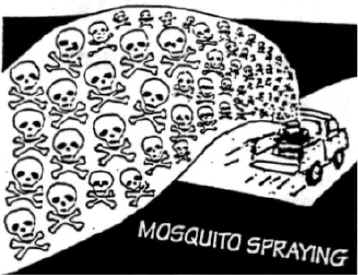 |
No Spray News James Irwin |
 |
No Spray News James Irwin |
May 21, 2002 Page 7
The Facts Don't Match the Hype (continued)
Ms. Brown told me that:
Meet Your Mosquitoes
Although The State routinely refers to "more than 50 different species" of mosquitoes here in the midlands, the two species shown on this page account for 75% of the mosquitoes caught in Richland County traps. (The traps don't catch the tiger mosquito).
| Culex
quinquefasciatus This mosquito with the long name is the one the city claims to be spraying for. it is called the house mosquito because it is attracted to light, and will find its way into your house if your screens are broken. In appearance, this mosquito is drab brown and nondescript - the complete opposite of the flashy black-and-white tiger mosquito. For its larval habitat, Culex quinquefasciatus prefers foul water pools and storm drains, It can be important in disease outbreaks because it bites both birds and people. I normally see only a few of these mosquitoes each year at my house. It's most active at dusk and dawn. |
|
Aedes vexans Even though this is the most common mosquito found in Richland County traps (particularly those adjacent to flood plains), I normally don't see it at my house. Aedes vexans is a flood water mosquito that lays its eggs on dry land in flood plains, and then hatches en masse after flooding rains. Besides the field marks shown, it also has white "elbows" on its hind legs (but not the broad white stripes that the tiger mosquito has). It's most active at dusk. |
|